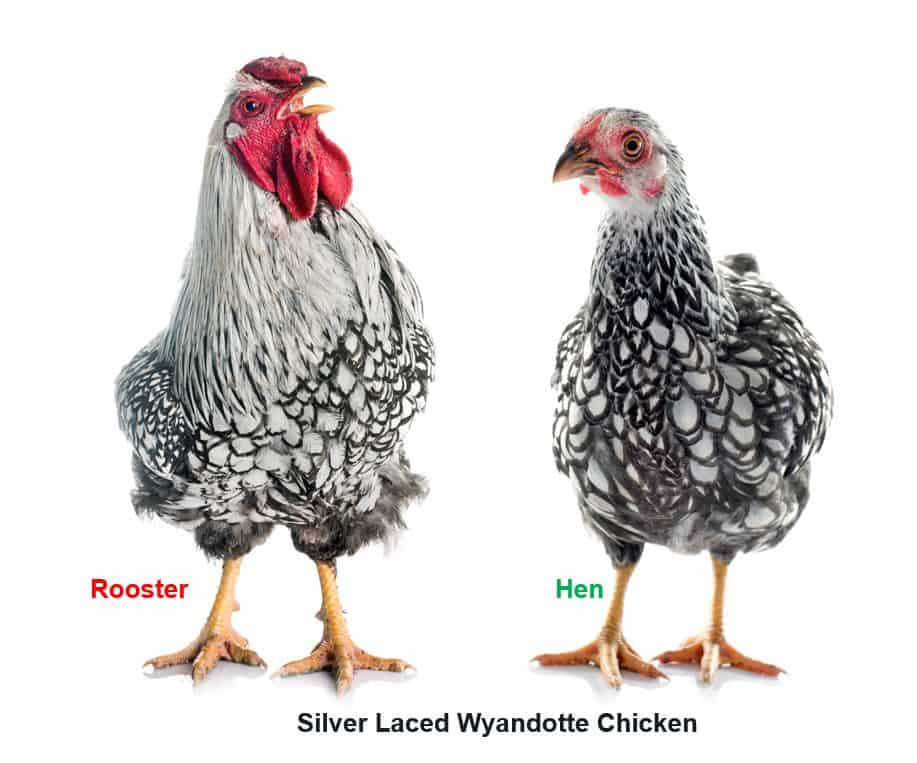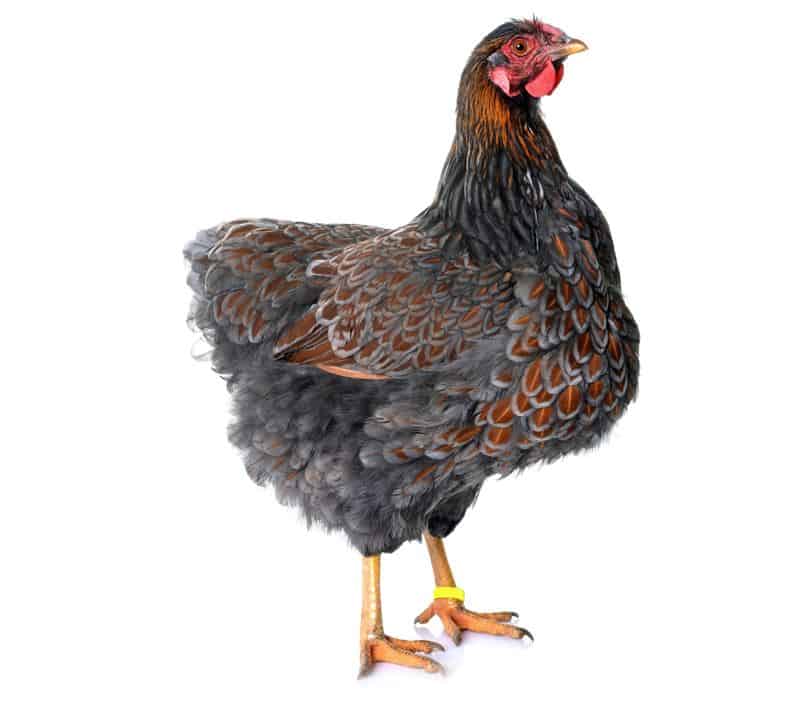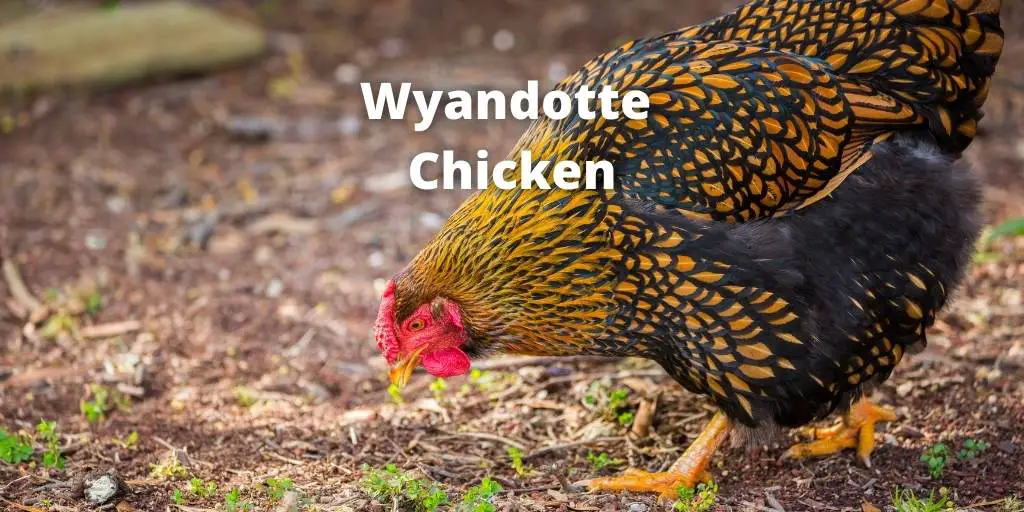Wyandotte Chicken is a splendid bird that looks beautiful and comes in several colors.
This bird has an American origin and is popular worldwide, not only because of its beauty but also because of its productive layers and great backyard companions.
This article discusses the Wyandotte Chicken, temperament, friendship, egg-producing capacity, etc.
Introduction to Wyandotte Chicken
The Wyandotte Chicken is one of the favorite chickens of America. It is created in the North-Eastern parts of the US.
This breed is highly reliable in eggs and meat production, so many homesteaders prefer it. It is the first American breed of chicken specifically bred to serve dual purposes.
Wyandotte Chicken is a beautiful heritage bird. Unfortunately, this word became less preferred with the advent of industrial farms.
The homesteaders and backyard chicken farm showed some interest in this bird and brought it back out of obscurity.
History of Wyandotte Chicken

The Wyandotte breed is an American chicken that is native to the state of New York. Wyandotte is actually the name of a Native American tribe and language, as is the name of the chicken breed.
The Wyandotte people weren’t much interested in the chicken, but the name resulted from the dedication of Native Americans who helped the white people to sell the first products in the area.
Besides, there is no other reason why Wyandotte was chosen as the name for this breed.
Many varieties of Wyandotte have been officially recognized. The Silver Laced Wyandotte, the Partridge, and the Buff are some wide varieties.
In the 1880s, the Wyandotte chicken was available internationally for the first time. It sailed across the Atlantic Ocean to serve the British poultry purveyors.
In 1904, it became more popular and expensive than the price of a Wyandotte chicken, and that of a manor house was almost the same.
Wyandotte Chicken Lifespan
The Wyandotte Chickens have a good life expectancy compared to other dual-purpose breeds. The Wyandottes have a lifespan ranging from 6–12 years.
The average life expectancy of the Wyandottes depends on the environment, nutrition, and care.
Recognized Varieties and Continental Breeds
Officially, the American Poultry Association recognizes eight colors of Wyandotte chicken in the United States.
Below is the most popular Wyandottes chicken, recognized variety:
- Black (1893)
- Columbian (1905)
- Buff (1893)
- Blue (1977)
- Golden Laced Wyandotte (1888)
- Silver Penciled (1902)
- Silver Laced (1883)
- Partridge (1893).
The Wyandotte started in its humble origin and developed and flourished over the years.
The first variety of Wyandotte chicken recognized by the American poultry association was the Silver Laced color chicken. It was accredited by the Standard of Perfection in the year 1883.
Other varieties were developed as a combination of Silver laced varieties with other desired colors and varieties, and some varieties were also developed as ‘sports’ of Silver Laced variety.
The white and black breeds were directly developed from the Silver laced as sports. Golden laced, Silver penciled, Columbian, and Partridge were crossed with other breeds to get the desired color.
- Four Silver Laced pullets were taken and located outside their coop.
- The Aho’s Partridge Wyandotte bantam has a black “penciling” pattern on the top and has a deep reddish background color.
Egg Production

Many people prefer Wyandottes chicken because of its good egg-laying capacity. The hens of this breed lay about 200 large size eggs per year. Wyandotte chickens lay light-brown or cream-colored eggs.
One major benefit is that it also lays eggs during winter. Here is the list of the best cold hardy chickens that lay eggs during cold weather.
Winter eggs are a common problem for other chicken breeds. Egg production of other chicken breeds almost stops during the cold winter months.
One of the excellent and unique abilities of the Wyandotte chickens is that it lay about four medium to large brown eggs each week.
Most, dual-purpose chickens usually have poor egg production. After all, people have to compromise on eggs if they want meat.
Also read: Types of Chickens That Lay Colored Eggs
Temperament
Wyandotte’s chickens are believed to be of good temperament, although some breeds have strong personalities, which make them seem aloof.
These are friendly and talkative chickens, but they aren’t ‘cuddly.’
These birds are typically dominant over others and are often at the top or near the pecking order. They are typically assertive and are seldom bullied, but they don’t appear to bully other birds.
They are also called rose-combed birds, as they don’t easily get frostbitten, and their comb sits much closer to the skull, which is ideal for colder climates. Wyandotte chickens having a single comb are typically found.
Still, these specimens of chicken breed are not officially recognized by the American poultry association and are also not used for breeding.
Color, Size, Appearance, Characteristics of Wyandotte Chicken
Color

Wyandotte is a sturdy chicken that weighs about nine pounds. It is found in several colors officially recognized by the American Poultry Association (APA).
Some colors are not officially acknowledged. Wyandotte’s roosters have an average weight of about nine pounds, while the hens are slightly smaller, weighing around 6–7 lbs.
The face, comb, earlobes, comb, and wattles of Wyandotte chicken are red. It has a beak that is dark golden-yellow. It has a unique eye of orange color.
The Wyandotte chicken was first officially recognized by the American Poultry Association in 1883.
Wyandotte, chicken color types, are as follows:
- 1883 – Silver laced
- 1888 – Gold laced Wyandotte
- 1893 – Black, partridge, Buff
- 1902 – Silver penciled
- 1905 – Colombian
- 1977 – Blue
Size
Wyandotte chickens are large size chickens, but the overall size of their body is a little compact despite their average weight. The weight of males is usually around 9 lbs, and hens have an average weight of about 6 lbs.
These are clean-legged birds, having a beautiful rose comb at the top of their heads. They have yellow skin, earlobes, and shanks, with red faces and wattles.
You can also consider Wyandottes in the meat chickens category.
Appearance
The Wyandotte is a heavy and sturdy-looking breed. Wyandottes are found in a wide range of beautiful colors and varieties developed as they spread across America.
They also have bright red combs and a little pale-colored leg. The laced variety of Wyandotte chicken is particularly striking and is one of the most popular breeds of the region.
The legs are yellow and are strong enough to hold the heavyweight of birds. The legs are clean, have no feathers, and each comprises 4 toes.
Further, their face, comb, earlobes, and wattles are all red, the beak is dark yellow, and the eyes are orange. Wyandottes are lovely, cute chicken breeds.
Characteristics

Below are some basic characteristics of Wyandotte chicken:
- Wyandotte chickens are large birds with clean legs and beautiful rose combs.
- These chickens have legs of dark yellow color.
- They have broad feathers loose-fitting, and the area around the vent is very fluffy.
- Feathers are usually laced and glamorous.
- Wyandotte chicken comes in nine glorious colors. The most famous of them is the Silver laced. Other colors are golden laced, Buff, black, partridge, Silver penciled, lavender, blue laced, and pure white.
- The comb and wattles are deep red.
- The average weight of males is 8.5 lbs, while that of females is 6 lbs.
Benefits of Raising Wyandotte Chicken
Wyandotte’s chickens are renowned for their versatile behavior in different climates. They are typically hard during the colder winter due to their heavy weight and feathering. They can also withstand the warm environments of summer.
Ensure you have plenty of shade for warm months and a well-ventilated coop. (Read about some Portable chicken coops)
Since the Wyandotte chicken is often large and has a beautiful rose comb, it performs impressively in winter. The flesh is less exposed to the cold winter air, reducing the risk of frostbite.
Wyandotte chickens are highly adaptable to any weather conditions; they also have high and tolerate confinement well. They are also good foragers.
Problems in Raising Wyandotte Chickens
Wyandotte chicken can be raised easily, with only a few disadvantages.
For the first time, when you interact with the Wyandotte chicken, dealing with their personality is a significant issue.
Most of the hens are quiet, but the Wyandotte are too talkative.
They make a lot of noise while laying eggs, and it occurs throughout the day, which is a significant issue.
Roosters also make a lot of noise. All chickens make noise, but the Wyandotte is known to be a bit more vocal and boisterous.
Care Guide for Wyandotte Chickens

If you are raising and caring Wyandotte’s chickens for the first time, you might face these issues-
- Most chicken breeds are quiet, but those with stronger personalities, like the Wyandotte chickens, are noisy and talkative. Some hens make noise while laying eggs; thereafter, they are quiet.
- Roosters, however, make noise throughout the day, which can annoy your neighbors. This is the main reason that some city ordinances prohibit the raising of roosters. You can use a no-crow collar to reduce your Wyandotte rooster noise.
- Starting and maintaining a coop is expensive initially, which you should be aware of. But the dual-purpose quality of this chicken will fulfill your needs and pay back your investment in meat and eggs.
- You have to be highly committed if you would like to keep the Wyandotte flocks happy. A significant amount of attention, patience, and determination is required at the start.
- However, it will become easy for you once you are familiar with these things and get a proper maintenance routine.
Conclusion
Wyandotte chickens are spectacular and cold-hardy birds. They supply us with great backyard companionship and fresh eggs throughout the year.
Wyandotte chicken recognized varieties have lovely colors. All of them are great colors and shades. They all are gorgeous and visually striking.
Wyandottes are easy to care for and make good show birds. If you want a chicken breed that will also be a great family pet and be wonderful, you can get a Wyandotte chicken.



Hi dear
had a question, please. I have two silver wyahdotte chickens. I bought them for a month. Unfortunately, they do not lay eggs. The nutrition is good. The place has a temperature between zero and 12 degrees Celsius, and I do not have a rooster. Thank you.
Are both the Wyandotte chickens were hen?? You must need a rooster for them.
you don’t need a rooster for the hens, but there are other thing that might affect laying. These include, but are not limited to:
-The amount of sunlight they get
-The age of the hens- They lay from about 5 months to about 2-3 years of
age.
-Their food’s protein content- Hens need protein to lay eggs, and may not
lay if they don’t get enough protein.
-Their environment- If they are in a small coop, or a dirty one, they might
not lay. If you have space, try to put in a nesting box
for them to lay in.
-Illness- It might turn out that your hens are sick, so you should get them
to a vet and find out. Sick hens won’t lay eggs.
-Climate- If you still aren’t getting eggs, you might want to give them a
heat lamp so they aren’t using all their energy to stay warm.
Also, There is such a thing where a chicken can be without a gender; these chickens never crow and never lay eggs. However, this is rare and highly unlikely, as I only got one chicken like that in my entire life
Oyster shells for strong egg shells. Those chickens are too young to lay eggs.